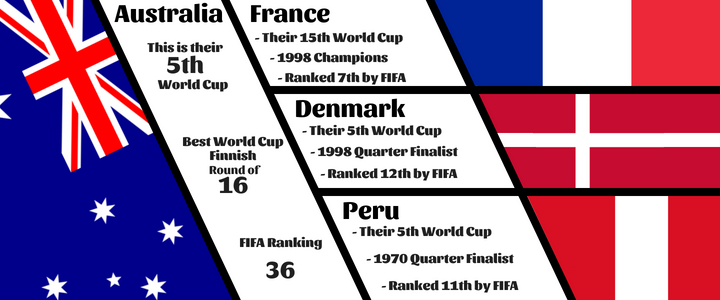The Socceroos’ campaign kicks off in two days with a match against international heavyweights France, before facing off against Denmark and Peru. How far can Australia get in the World Cup and can they beat the previous best effort of 2006’s Round of 16 performance? Hatch Macleay looks at the stats behind the group.
Australia:
This will be the Socceroos’ fifth world cup appearance, after appearing in the tournament in 1974, 2006, 2010, 2014 and now 2018. This is a new generation of Socceroos, with 18 world cup debutants making the trip to Russia. However, this squad is not by any means lacking in experience, with Tim Cahill sitting on an incredible 106 caps and 50 international goals heading into his fourth world cup appearance.

After an underwhelming qualifying campaign including draws which included draws with Thailand and Iraq, as well as a chastening loss to Jordan, Bert Van Marwijk replaced former coach Ange Postecoglou. And in the early days we have seen moments of promise, but also madness in his four preparatory friendlies for the tournament, with a damaging 4-1 loss to Norway followed by a creditable 0-0 draw with Colombia and wins against the Czech Republic and Hungary.
The biggest problem the Australians must address, however is the problem of scoring goals. Outside of Tim Cahill, who looks set for a bit part role in his final world cup, they do not possess a proven international level goalscorer. Strikers, Tomi Juric, Jamie Maclaren, Daniel Arzani and Andrew Nabbout have a combined 10 goals in 47 appearances. If these men can recover their scoring touch, experienced defensive minds such as Mile Jedinak, Trent Sainsbury and goalkeeper Matthew Ryan might just see them through the group.
#WorldCup preparations in Kazan #GoSocceroos pic.twitter.com/GKIYyCV9zA
— Socceroos (@Socceroos) June 13, 2018
France:
If Australia is lacking top class pedigree, then only the opposite can be said for group rival, France. One of the favourites for the tournament, the French, who were runners up at the 2016 European Champions have world class quality all over the pitch. From Atletico Madrid’s Antoine Griezmann up front, through Paul Pogba and Ngolo Kante in midfield and Hugo Lloris in goal, they are well equipped to dominate group C and go far in the tournament.
There is hope, however for their lesser fancied rivals, given that under Didier Deschamps, the French have been found wanting on occasion, particularly against smaller sides who sit deep and make life difficult for their more fancied opponents. Since the European Championships, France have thrown away a two-goal lead against Colombia to lose 3-2 in Paris, as well as drawing to Belarus and Luxembourg and losing to Sweden in their world cup qualifying group. It is this sort of inconsistency that could cripple these giants, despite their undeniable star power.
When you realise there are just 4⃣ days to go until Les Bleus’ @FIFAWorldCup opener against @Socceroos! 👊#FiersdetreBleus #FRAAUS pic.twitter.com/SiieDqWbGo
— French Team (@FrenchTeam) June 12, 2018
France’s long term advantage, however, is that even if they can’t deliver the World Cup for the fans of Les Bleus, their team is arguably not even at its peak yet. With an average age of 25 and stars such as Kylian Mbappe and Ousmane Dembele, not even 22 years-old, this is a squad geared for the future.
Denmark:
The days of Michael Laudrup and Peter Schmeichel may be behind them, but the Danes are very much a team to be respected.
They came second behind Poland in their qualification group, conceding a very impressive eight goals in ten matches, with a defence marshalled by Sevilla colossus Simon Kjaer.
With Leicester City goalkeeper Kasper Schmeichel and Chelsea prodigy Andreas Christensen holding the defence together, this will be a tough unit to break down.
However, Denmark are not just a one-trick pony; going forward they have one of the most talented attacking midfielders on the planet in Tottenham Hotspur’s Christian Eriksen.
The 26-year-old was already a talent at former side Ajax, but since joining Tottenham, the young maestro has become a talisman for club and country.

With 11 goals and 3 assists in 1080 minutes in qualifying, he will carry most of the offensive responsibilities for his side.
However, this over-reliance on Eriksen could be a downfall for the Danes, with the rest of their attack looking rather underwhelming by comparison.
Compared to Eriksen’s 22 goals for his country, the six other forwards listed for Denmark have only 26 goals between them.
Saying all a team needs to do against Denmark is shut down Eriksen is far too simplistic, but it will certainly go a long way to getting a result against them.
Peru:
One of the less fancied South American nations, the Peruvians are at their first world cup since 1982, and will be looking to make the most of it.
They came through the South American qualification phase in fifth place, holding off South American champions Chile to snatch the final qualification spot on goal difference.
Peru’s captain, Paolo Guerrero has been at the centre of a cocaine scandal, but under the support of the French, Australian and Danish captains, he will take part in the tournament, despite a 14-month ban for testing positive for cocaine.

Photo credit: @SeleccionPeru
And with 34 goals and 88 caps, his coolness in front of goal and international experience will be invaluable in Peru’s first tournament in 36 years.
Peru’s star man at the world cup will be Lokomotiv Moscow winger Jefferson Farfan, who has played in the Bundesliga against some of the best players in the world.
However, it’s at the other end of the pitch where the Peruvians are likely to suffer, conceding a worrying 26 goals in 18 qualifying matches. If they can’t plug the gaps in their defence this could well be a short stay in Russia for Guerrero’s men.


